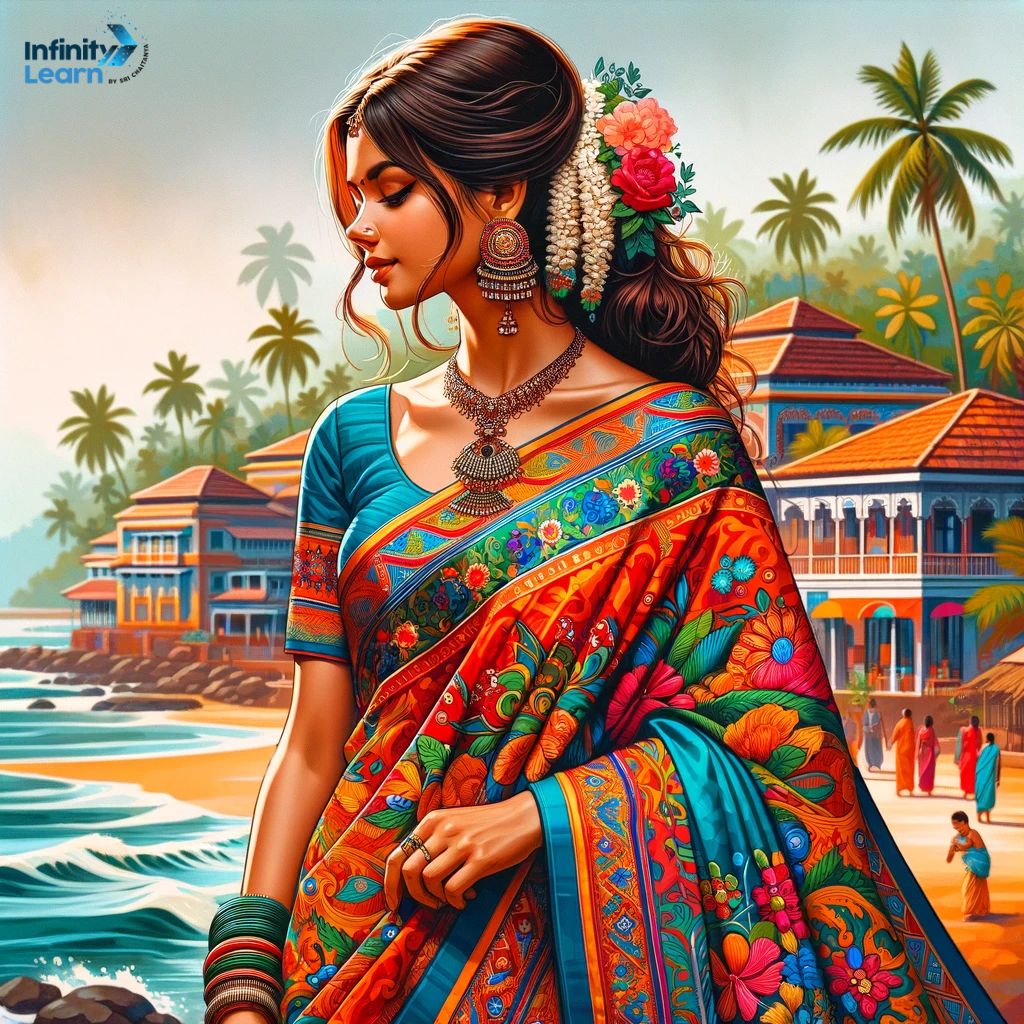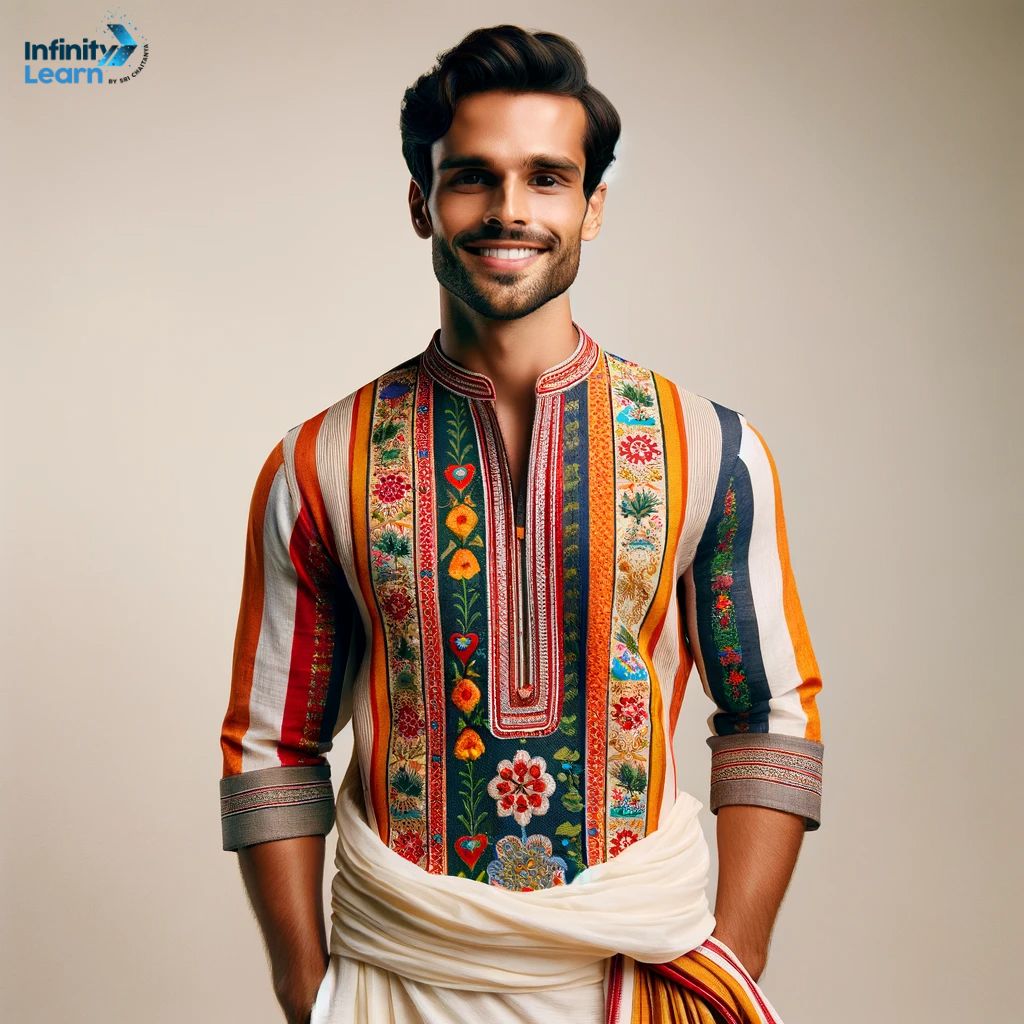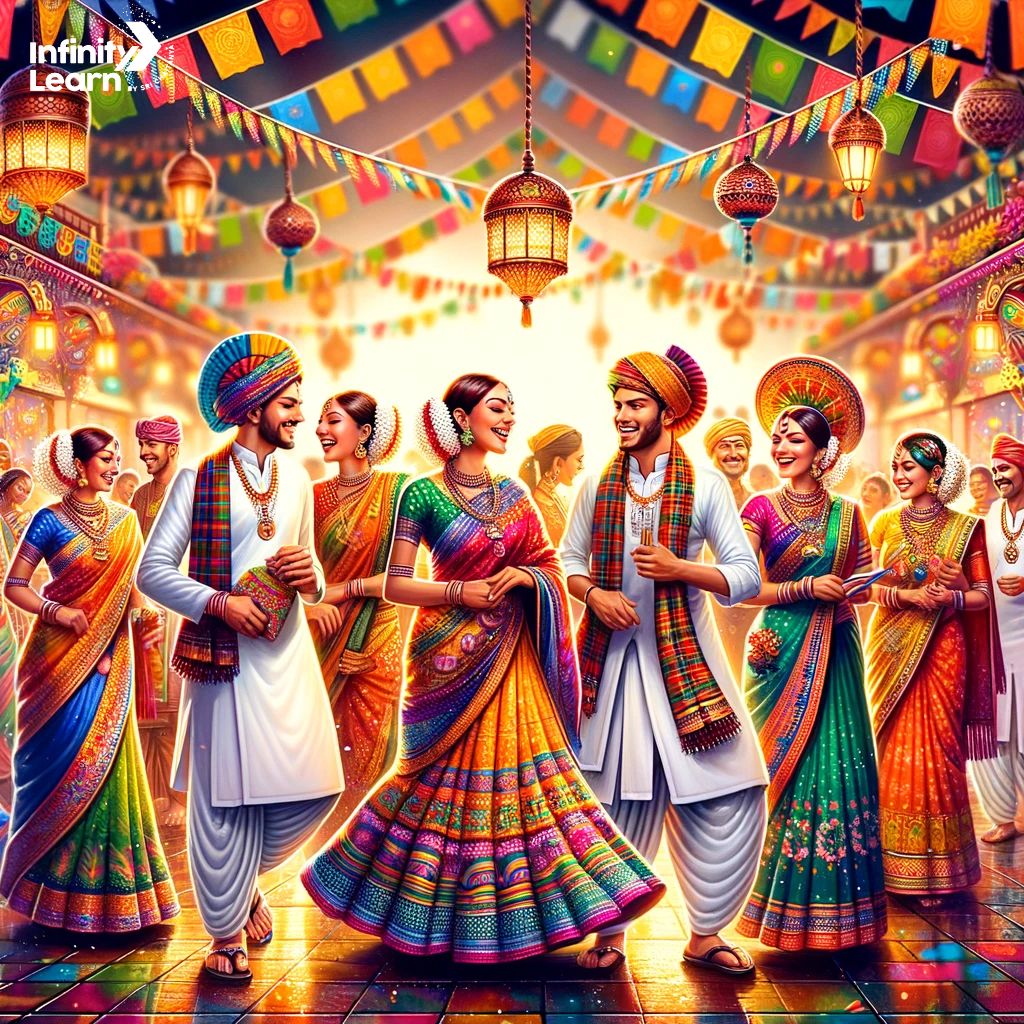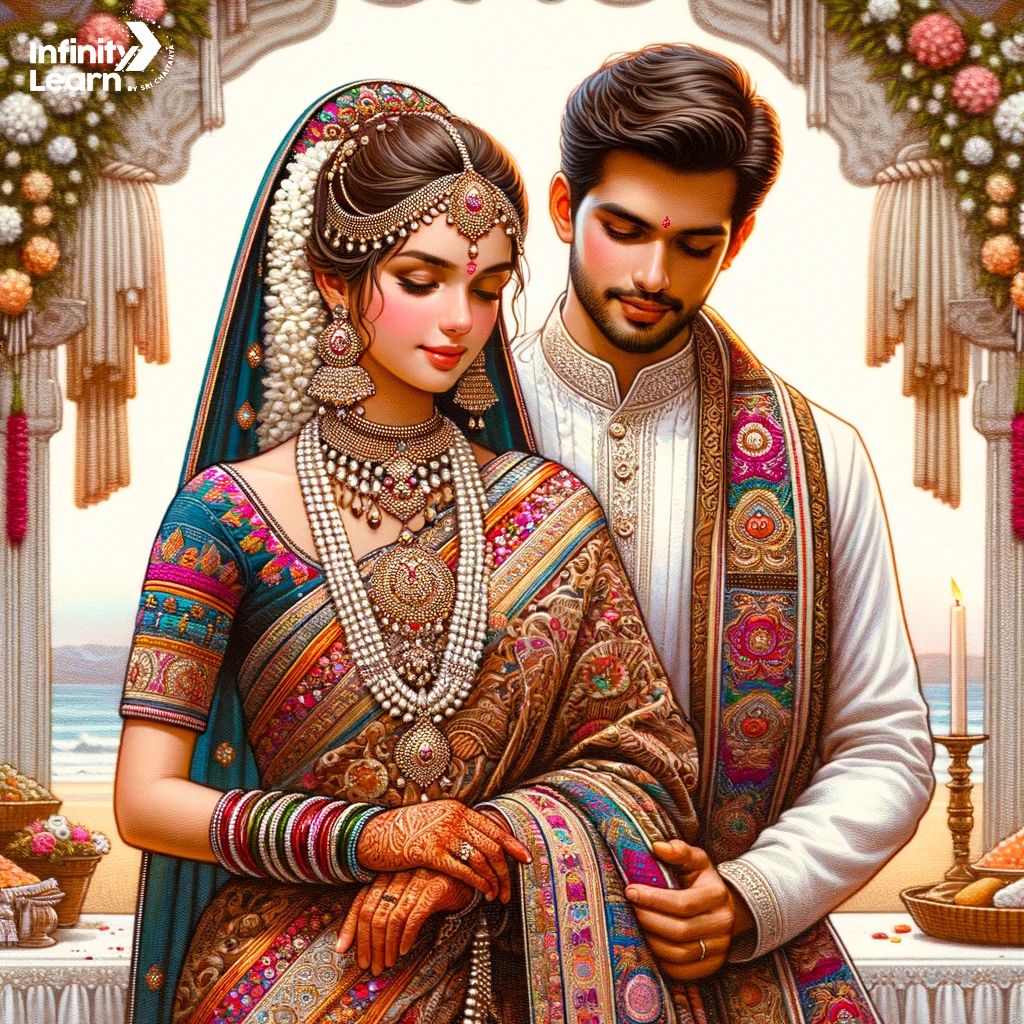Table of Contents
History of Goa Traditional Dress
The history of Goa’s traditional dress are a rich tapestry of cultural influences. Goa, with its unique position on the western coast of India, has seen a blend of indigenous traditions and Portuguese colonial influence in its traditional attire.
One of the most iconic garments is the ‘Pano Bhaju,’ a symbol of Goan cultural attire. This traditional Goan clothing for women combines a blouse (‘Pano’) and a long skirt (‘Bhaju’), often paired with a shawl, reflecting the blend of Indian and Portuguese styles. This attire is prominently featured in Goa traditional dress images and is a staple during Goan festivals and ceremonies.
For men, the traditional dress of Goa tends to be more influenced by Portuguese fashion. It usually includes formal shirts and trousers, with rural attire being simpler for practicality. The Goan traditional outfit for men is a reflection of Goa’s history and lifestyle.
Children in Goa often wear smaller versions of adult clothing. Goa traditional dress for girl and boy includes colorful Pano Bhaju or miniature shirts and trousers, maintaining the cultural dressing style.
| Rajasthani Traditional Dress | Traditional Dress of Gujarat |
| Kerala Traditional Dress | Odisha Traditional Dress |
| Maharashtra Traditional Dress | Traditional Dress of Arunachal Pradesh |
Traditional Dress of Goa for Goan Catholics
Goa, a state renowned for its vibrant culture and history, has a unique traditional dress that reflects its rich heritage. For Goan Catholics, traditional attire is not just clothing; it’s a celebration of their identity and customs.
Women’s Attire: The Pano Bhaju The traditional dress for Goan Catholic women is known as “Pano Bhaju.” This outfit is both beautiful and symbolic. It typically consists of a blouse, a long skirt, and a shawl. The skirt, often brightly colored and adorned with prints, is worn with a matching blouse. The shawl, or “pallu,” is draped over the shoulder, adding elegance to the ensemble. The Pano Bhaju, regarded as a hallmark of Goan cultural attire, showcases intricate designs that often reflect the craftsmanship of Goan artisans.
Men’s Attire: Simplistic Elegance For Goan Catholic men, the traditional dress is more understated but equally significant. It usually involves a simple, white shirt paired with formal trousers. In some instances, especially during festivals or weddings, men might accessorize their attire with a traditional hat, adding a touch of Goan ethnic dress to their look. This combination, though simple, is steeped in tradition and is a vital part of Goan ceremonial dress.
Significance in Festivals and Weddings Traditional Goan clothing plays a pivotal role during festivals and weddings. In these events, you’ll find a colorful display of Goan traditional wear, with both men and women donning their ethnic best. The Pano Bhaju for women transforms into a more elaborate version, often embellished with jewelry and intricate embroidery, symbolizing joy and celebration.
Tradition in Modern Times In modern times, while everyday fashion has evolved, the essence of traditional Goan attire remains alive, especially in the way Goan Catholics dress for special occasions. These garments are not just clothes; they are a testament to Goa’s history, a blend of indigenous and colonial influences, and a symbol of cultural pride.
Traditional Dress of Goa for Non-Catholics
Goa, a vibrant state in India, is known for its rich cultural diversity. This diversity is prominently reflected in the traditional dress of Goa’s non-Catholic population. Unlike the Catholic community, which often wears Western-style clothing for their ceremonies, the non-Catholic community in Goa, predominantly Hindu, embraces a different set of traditional wear.
For women, the Goan saree is the most common traditional dress. This is not just any saree; it’s often rich in color and design, reflecting the lively spirit of Goa. Unlike the more commonly known styles of draping sarees in India, Goan women drape their sarees in a unique way, known as the “Nav-Vari” style, which gives a distinctive look, elegant yet full of heritage.
Men typically wear what is known as a “Kurta” or “Panche,” a long shirt and a kind of sarong, which is a comfortable yet traditional choice. This attire represents the simplicity and earthiness of Goan culture. The traditional dress for men isn’t just limited to religious or cultural ceremonies; it’s also worn in daily life, symbolizing the integration of tradition into the everyday.
During festivals and special occasions, the traditional attire becomes more elaborate. Women may adorn themselves with intricate jewelry and more ornate sarees, while men might opt for a more decorative Kurta.
It’s important to note that Goan traditional clothing is not just about the garments themselves, but also about preserving and celebrating the region’s history and traditions. Each piece of clothing, whether it’s the Goan saree for women or the Kurta for men, tells a story of the state’s past and its cultural evolution.
| Culture of Rajasthan | Culture of Kerala |
| Culture of Manipur | Culture of Assam |
| Culture of Andaman and Nicobar Islands | Culture of Telangana |
| Culture of Bihar | Odisha Culture |
Different Types of Goa Traditional Dresses
Goa, known for its distinct traditional dresses, reflecting a blend of Indian and Portuguese influences. These outfits not only showcase the state’s rich heritage but also its unique fashion sense.
Goa Traditional Dress for Women
The most popular traditional dress for women in Goa is the ‘Pano Bhaju’. This outfit typically consists of a colorful saree, worn with a blouse and a petticoat. The saree, known for its bright colors and intricate designs, is draped elegantly, highlighting the Goan dressing style. The ‘Nav Vari’, another traditional Goan saree style, is also favored by many women, especially during festivals and special occasions.

Goa Traditional Dress for Men
For men, the traditional Goan attire often includes a simple yet elegant kurta and trousers. This combination is known for its comfort and suitability for Goa’s tropical climate. The ‘Kupya’, a traditional long tunic worn over trousers, is another popular choice, especially in rural areas of Goa. These garments reflect the simplicity and practicality of Goan ethnic dress.

Traditional Attire for Goan Children
Children in Goa also have their traditional outfits. Girls often wear miniature versions of the Pano Bhaju or other colorful sarees, while boys may dress in kurtas and trousers, similar to the adult males. These outfits are particularly prominent during cultural festivals and religious ceremonies.
Goan Folk Costumes and Ceremonial Dress
Goa’s folk costumes, worn during traditional dances and cultural performances, are a feast for the eyes. These are usually more elaborate, with additional accessories and decorations, showcasing the Goan ceremonial dress in all its glory. Women’s folk costumes often include intricately embroidered blouses and flared skirts, while men’s costumes might feature vibrant shirts and decorative headgear.
Traditional Dress Of Goa During Festivals
Festivals in Goa are a vibrant display of culture and tradition, where the Goa traditional dress plays a significant role. During these times, locals dress in colorful and elaborate outfits that reflect their rich heritage.
For women, the Goan saree styles are particularly prominent. These sarees are often bright and decorated with intricate designs. The most notable among these is the Pano Bhaju, a traditional Goan costume for Catholic women. It’s a combination of a blouse and a full-length skirt with a shawl, known for its elegance and grace. The Goan traditional outfit for Hindu women usually involves a saree worn in a specific drape, unique to the region.

Men typically wear a simple yet elegant attire. The traditional dress of Goa male includes a shirt, trousers, and sometimes a jacket. During festivals, these are often in brighter colors and finer fabrics. The Kunbi Saree and Kupya (a traditional shirt) are also seen during these times, showcasing the blend of indigenous and colonial influences in Goan fashion.
During festivals like Carnival, Shigmo, and the Feast of St. Francis Xavier, you’ll see a beautiful array of these traditional costumes. The Goan folk costume comes alive in these celebrations, with each outfit telling a story of Goa’s diverse history.
Goa Traditional Dress Name
Below there are list of Goa traditional dress name male and female:
Goa Traditional Dress Name Female
- Nav Vari
- Kashti
- Valkal
- Feni Suit
- Kunbi Saree
- Kupya
Nav Vari
The Nav Vari, also known as the nine-yard saree, is a traditional form of Goan saree styles. Unlike the more common five-yard sarees, this longer version wraps around the body in a unique manner, offering a blend of elegance and cultural heritage. It’s often seen in vibrant colors and intricate designs, symbolizing the rich Goan cultural attire.
Kashti
Kashti refers to a traditional Goan drape, usually a part of men’s attire. It’s a form of a loincloth or a wraparound skirt, which is an integral part of the Goan traditional dress male wardrobe. The Kashti is known for its simplicity and comfort, reflecting the laid-back yet culturally rich lifestyle of Goa.
Valkal
Valkal might not be a direct part of the contemporary Goa traditional dress, but it holds historical significance. In ancient times, Valkal was made from tree bark and leaves, representing a primitive form of clothing. Today, it symbolizes the connection of Goan culture with its ancestral roots and nature.
Feni Suit
While not as traditional as other attires, the Feni Suit has become synonymous with modern Goan fashion. Inspired by the famous Goan Feni drink, this attire often features light, airy fabrics and is popular among both Goa traditional dress male and female wearers. It represents the fusion of traditional Goan elements with contemporary fashion trends.
Kunbi Saree
The Kunbi Saree is a cornerstone of traditional Goan clothing, especially among the tribal women of Goa. This saree is simple in design, reflecting the needs of the agrarian lifestyle of the Kunbi tribe. It’s a testament to the enduring nature of Goan ethnic dress traditions and is now celebrated as a symbol of Goan heritage.
Goa Traditional Dress Name Male
- Kurta
- Pajama
- Kupya
- Kob (Traditional Hat)
- Shirt-Pant Combination
Traditional Dress of Goa Couple
The traditional dress of a Goan couple embodies the rich cultural heritage and vibrant history of Goa. This coastal state in India is known for its unique blend of Indian and Portuguese influences, which is also reflected in its traditional clothing.
For women, the most iconic attire is the ‘Pano Bhaju’, a traditional Goan dress. This dress is a beautiful fusion of Indian and Western styles. It consists of a blouse or ‘Choli’ and a long skirt or ‘Pano’. The blouse is typically embroidered with intricate designs, and the skirt is often adorned with colorful prints or patterns. The ensemble is completed with a ‘Kunbi Saree’, a simple yet elegant saree that is draped over the shoulder. The Goan saree styles have evolved over time, incorporating various designs and fabrics, but always maintaining a sense of traditional charm. The Goan traditional dress for girls often mirrors the adult version but is adapted to be more comfortable and suitable for younger wearers.

For men, the traditional attire is quite distinct and simple. The Goan traditional dress for men typically includes a formal shirt, usually white in color, paired with a half pant, which is known as ‘Pudvem’ or ‘Kashti’. This combination is both practical and comfortable, suited to the tropical climate of Goa. In more formal settings or during special occasions, men might wear a full-length trouser or even a suit, reflecting the Portuguese influence. The traditional dress of Goa male has remained relatively unchanged over the years, symbolizing the simplicity and down-to-earth nature of Goan culture.
FAQs on Goa Traditional Dress
What is the traditional dress of Goa?
The traditional dress of Goa varies between genders. For women, it's typically the 'Pano Bhaju' paired with a Kunbi Saree, and for men, it's a simple white shirt with half pants known as 'Pudvem' or 'Kashti'.
What is the history of clothing in Goa?
The history of clothing in Goa reflects its Indo-Portuguese heritage. Traditional Goan clothing has evolved over time, blending Indian aesthetics with Portuguese influences, evident in the unique styles of Pano Bhaju for women and Kashti for men.
What is the traditional dress of Goa men?
The traditional dress of Goa men includes a formal, often white, shirt paired with half pants known as 'Pudvem' or 'Kashti'. This attire is simple yet elegant, designed for the tropical Goan climate.
What kind of dress do you wear in Goa?
In Goa, people often wear lightweight, casual clothing due to the warm climate. Traditional attire like Pano Bhaju for women and Kashti for men is worn on special occasions. Beachwear and light cotton clothes are popular for everyday wear.
What kind of shoes to wear in Goa?
In Goa, comfortable footwear like sandals or flip-flops is recommended due to the warm weather and sandy beaches. For walking in the city or visiting temples, closed-toe shoes or sneakers are suitable.
Is it okay to wear jeans in Goa?
Yes, it is okay to wear jeans in Goa, especially during the cooler months. However, due to the humid and warm climate, lighter fabrics are generally more comfortable for everyday wear.
Can we buy clothes in Goa?
Yes, you can buy clothes in Goa. The state has a variety of markets and shops selling everything from traditional Goan clothing to modern beachwear, offering options for all preferences and budgets.








